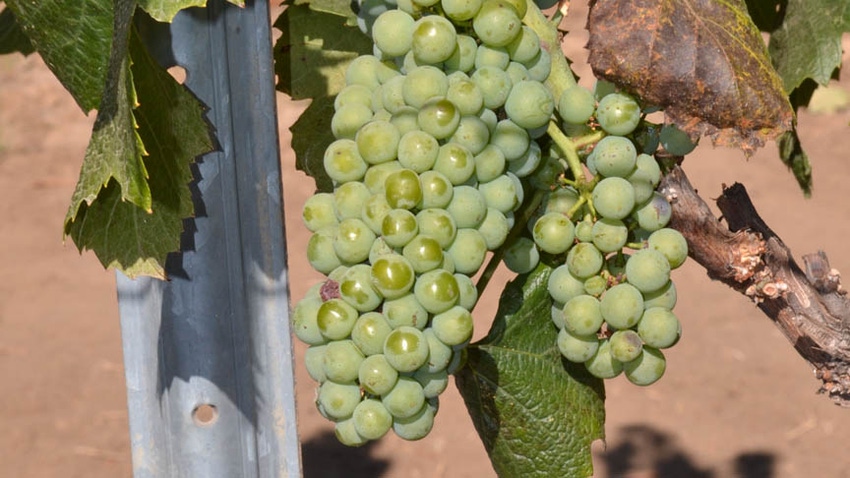
Aided by warm spring weather, including just one night of frost, Jim Fetzer’s Lake County wine grape vines came out the gate strong and early. Continuing to develop nicely through the season, his crop is now headed for an early harvest. In his area that’s typically one that starts the first week of September. This year, it could be even earlier.
By Aug. 14, some of his Sauvignon Blanc grapes were at 20º to 21º Brix with the possibility of being harvest-ready within another seven to 10 days, he reports.
Fetzer owns Ceago Vinegarden near Nice, Calif. In addition to his two main varieties, Sauvignon Blanc and Cabernet Sauvignon, he grows Syrah, Cabernet Franc and Malbec along with Chardonnay and Muscat.
His 49-acre vineyard is situated at an elevation of 1,400 feet in a protected area along the shores of Clear Lake, where the landscape sports some palm and citrus trees. There the vines enjoy winter temperatures often as much as 10 degrees warmer than those just a 15-minute drive away in Upper Lake.
This year they’ve taken advantage of this season’s favorable growing conditions. “It’s a good, solid crop and above average in quality and tonnage,” Fetzer says. “The color is coming on quickly and, due to our usual fog-free summer weather, the grapes are ripening quickly with good, soft tannins.”
This summer has included a few days of heat. That’s where the lakeside location offers another advantage. If the forecast calls for some really high temperatures, he turns on his sprinklers in the morning to cool the vines with water pumped from the lake.
When Fetzer established the vineyard in 2001, he planted 37 different clones, including some new ones. “The vineyard was like a big spice rack,” he recalls.
By making small batches of wine, he was able to experiment and test the wine-making qualities of the various clones when grown at the same site. At the time, Fetzer had a small winery with many 5-ton vessels than enabled him to separate the wine from the various clones, process them all within the same year and compare the differences.
Virginia creeper leafhopper
Fetzer’s vineyard earned organic and biodynamic certification in 2003. This year, however, he lost both certifications. He was unable to control an infestation of the Virginia creeper leafhopper, a recent arrival in the North Coast area, using a soft-chemistry material that he’s used successfully to control the western grape leafhopper.
The leaf-feeding Virginia creeper leafhopper is also called the zigzag leafhopper because of markings on its back.
“It’s very vicious and sucks all the chlorophyll out of the leaves,” Fetzer says. “We’ve seen it in the vineyard the past three years. This season it came out about three weeks before the western grape leafhopper and got out of hand.”
The tiny Anagrus spp. wasp, which controls western grape leafhoppers by parasitizing its eggs, seems to have no effect in controlling the Virginia creeper leaf hopper, he notes.
Pyganic, a pyrethrin-based broad-spectrum insecticide, which is registered for organic and biodynamic crop production, kills only the nymph stage of this pest, Fetzer says. Also, it kills beneficial insects.
“It doesn’t affect adults,” he says. “So it’s hard to get a really good kill.”
Fetzer spends about $180 to $200 an acre for the material plus application costs to treat his vineyard with Pyganic.
Even as many as four applications of the insecticide this season would not have controlled the Virginia creeper leafhopper, Fetzer says. So, he switched to Montana, an imidacloprid that is not approved for organic or biodynamic production. He treated his vineyard one time with the product, at a cost in material of $18 per acre. That was in mid-June after all the eggs had hatched so that he could target the adults.
“We had no choice,” Fetzer says. “Otherwise, we would have ended up at the end of the year with little chlorophyll in the leaves and difficulty getting the fruit to ripen. We lost our certification. But the synthetic product did a really good job and saved our vines.”
Other than that, this has been a great season for growing grapes, Fetzer adds.
“It’s been a good year,” he says. “We’ll take this year every year, but without the Virginia creeper.”
If you would like to read more about California grape growing, subscribe to GrapeLine, the exclusive electronic newsletter sponsored twice a month by Chemtura: See here for sign-up. It’s free and e-mailed the second and fourth weeks of each month from March through October.
More from Western Farm Press
Save the cockroaches, flies, fleas, white grubs
About the Author(s)
You May Also Like




